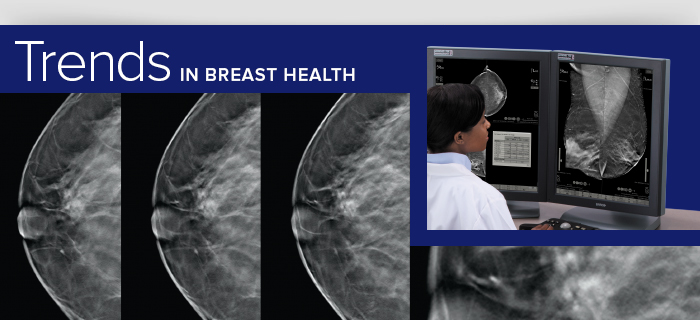JAMA Adds Significant Support for the Use of 3D Mammography in Breast Cancer Screening
.................................................
Pathologic Response in Breast Cancer Treated With Neoadjuvant Therapy
.................................................
Is This the Final Word on Margins?
.................................................
Breast Cancer Treatment – Mastectomy is not the Only Answer
.................................................
Hologic Symposium Now Available Online
.................................................
Enhance Patient Communication With the drawMD Breast Health App
.................................................
Editor's Bios

Pamela Benitez, MD
Dr. Benitez is a general surgeon
focusing exclusively on diseases
of the breast and breast cancer
at William Beaumont Hospital in
Royal Oak, Michigan.
Martin Keisch, MD
Dr. Keisch is a board-certified radiation oncologist at University of Miami Hospital and President of Cancer HealthCare Associates (CHCA).
Laurie Fajardo, MD
Dr. Fajardo is a board certified radiologist and Professor of Radiology at the University of Iowa Hospitals and Clinics with a heavy focus on breast tomosynthesis.
|
Multi–institutional Study Published in the Journal of the American Medical Association (JAMA) Adds Significant Support for the Use of 3D Mammography in Breast Cancer Screening
The publication of a large multi-institutional study in JAMA in June 2014 provides strong evidence in support of the use of 3D mammography in breast cancer screening.1 For 13 academic and community-based breast centers, the trial examined the performance of conventional digital mammography during the one-year period before the site started to use 3D mammography to the performance of the site after 3D mammography was introduced. Data collection ended in December 2012.
Read more >>
Pathologic Complete Response in Breast Cancer Treated With Neoadjuvant Therapy
Is This the Final Word on Margins?
Local recurrence rates have been reported in classic studies with long-term follow-up to be low in cases of invasive cancer ranging from 10–15%. In the Society of Surgical Oncology-American Society for Radiation Oncology Consensus Guidelines, IBTR averaged 5.3% (range 2.3–7.6%) in the 33 studies that were evaluated and used for the report.2 The patients in these studies were all treated with whole breast radiation therapy following lumpectomy.
Read more >>
Breast Cancer Treatment – Mastectomy is not the Only Answer
Chief, Gynecologic Cancer and Breast Cancer Services, UCSD Department of Radiation Medicine and Applied Sciences
Each day in my office, I see the sheer panic on the faces of women diagnosed with breast cancer. The statistics are astounding. According to the American Breast Cancer Society, the chance of a woman having invasive breast cancer during her life is about one in eight. A growing number of the women I meet think mastectomy is their only option in the face of a diagnosis. But often it's not.
Read more >>
Hologic Symposium Now Available Online
The panel of breast surgeons and Washington healthcare experts discussed what a value-based healthcare system means today for breast surgeons in both private and hospital-owned settings, and explored what this will mean for the future of breast care. The symposium covered more specific and actionable topics, such as the basics of accountable care, and the tools available to help track and report outcomes in order to succeed in a value-based payment model. Most importantly, the experts shared their own experiences and tips on aligning the goals of the patient, provider and payer so that everyone wins.
Learn more about the event, and/or view the video today by visiting: www.hologic.com/asbs
Enhance Patient Communication With the drawMD Breast Health App
drawMD Breast Health is a simple tool created to enhance doctor-patient communication at the immediate point of care. The free mobile application, created by Visible Health and sponsored by Hologic, enables physicians to visually communicate breast anatomy, conditions, procedures and concepts with their patients.
Over nine canvases, or background images, and ninety interactive stamps allow physicians to easily annotate and visually explore breast health topics as broad as general breast anatomy, benign or malignant breast conditions, breast biopsy procedures, surgical interventions, and radiation oncology therapies. Additional patient resources developed by Hologic, including videos and downloadable pamphlets, provide physicians with interactive educational content on the go to help them guide patient discussions and improve understanding.
The drawMD app empowers breast health professionals to not only enrich the in-person experience with visual aids, but also to share that same information discussed during the appointment, via e-mail or print post-visit, helping improve health literacy and information retention.
To find out more about this new app, visit www.drawmd.com/breasthealth or download the iPad app drawMD Breast Health free of charge at the Apple AppStore.
The comments and personal stories of the individuals mentioned in this piece are not necessarily those of Hologic.
This information is intended for medical professionals or specific product users residing in the United States and other locations where distribution of such information is permitted and should not be considered as a solicitation or promotion of any product or of an indication of any product that is not authorized by the laws and regulations of another country where the reader resides. This information could refer to products that are or may not be available in any particular country, and/or may not have received market clearance by a governmental regulatory body for indications and restrictions in different countries. Hologic, C–View and associated logos are trademarks and/or registered trademarks of Hologic, Inc. and/or its subsidiaries in the U.S. and/or other countries. |
|

